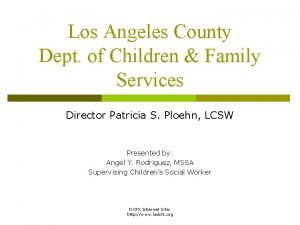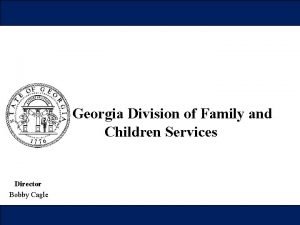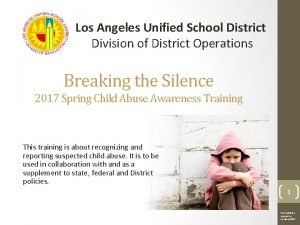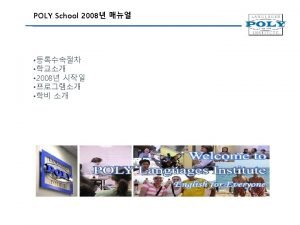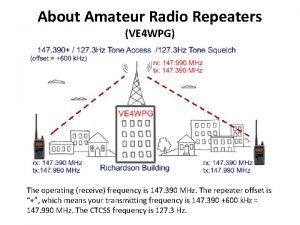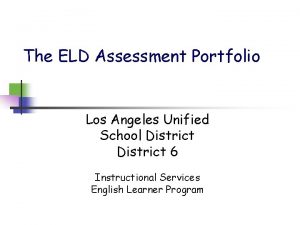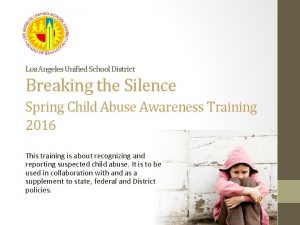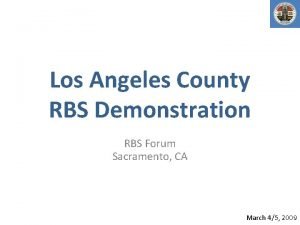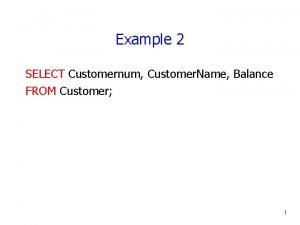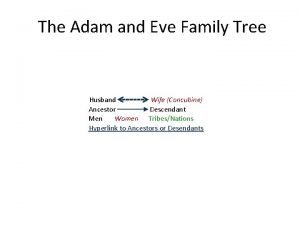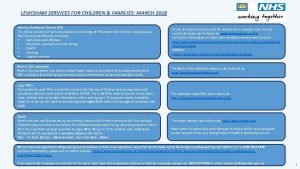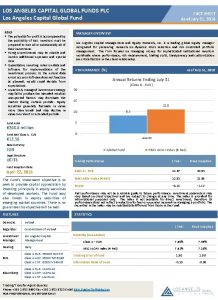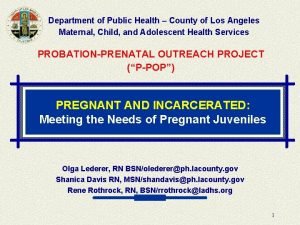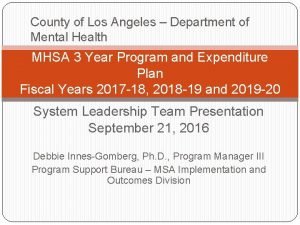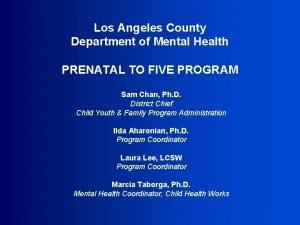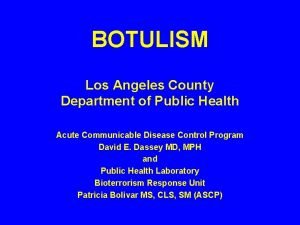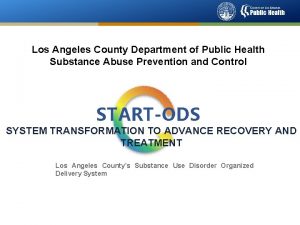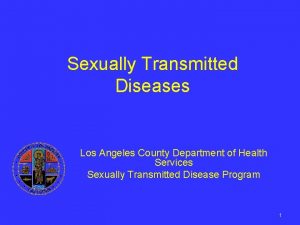Los Angeles County Department of Children and Family




























































- Slides: 60

Los Angeles County Department of Children and Family Services Data-Driven Decision Making Leadership Organizational Group Safe Children. Healthy Communities. Strong Families.

Welcome

Data-Driven Decision Making Leadership Organizational Group Director’s Message Bobby D. Cagle

Data-Driven Decision Making Leadership Organizational Group Chief Deputy Director Ginger Pryor

Data-Driven Decision Making Leadership Organizational Group Deputy Director Kym Renner

Data-Driven Decision Making Leadership Organizational Group Division Chief Roxanna Flores. Aguilar

Data-Driven Decision Making Leadership Organizational Group Wendy Wiegmann California Child Welfare Indicators Project

CALIFORNIA CHILD AND FAMILY SERVICES REVIEW (C-CFSR) PROCESS te ni ch ca a System Improveme nt Plan Peer Review e nc County Self. Assessment ce n a t is s s la ca ni ch te Annual Progress Reports ta ni h c te is ss la l a c is st s ce n a e nc ta is ss la a c ni h c te

LOS ANGELES COUNTY’S SYSTEM IMPROVEMENT PLAN (SIP) GOALS q. Priority One - Recurrence of Maltreatment Target Improvement Goal: By 2020, Los Angeles County will meet or surpass the 9. 1% National Standard for four consecutive quarters for children 0 -5 years of age and African American children and youth.

LOS ANGELES COUNTY’S SYSTEM IMPROVEMENT PLAN (SIP) GOALS q. Priority Two- Permanency in 12 Months for Children Entering Foster Care Target Improvement Goal: By 2020, Los Angeles County will improve by 10%. This represents a goal of 40. 1% for Child Welfare and 35. 3% for Probation.

LOS ANGELES COUNTY’S SYSTEM IMPROVEMENT PLAN (SIP) GOALS q Priority Three- Enhance County Case Review System Target Improvement Goal: By 2020, Los Angeles County will increase the percentage of CFSR case reviews receiving a “Strength” rating for Child Well. Being Items 12 (Needs Assessment & Provision of Services) and 13 (Family Engagement in Case Planning).

SYSTEM IMPROVEMENT EFFORTS Invest LA Strategic Planning Office of Equity and Inclusion Parents in Partnership P 3 Family Finding population 0 -5 Champion Groups in regional offices Increased use of Child & Family Team (CFT) meetings, with better quality Up-Front Family Finding Resource Family Approval (RFA) All Staff Implicit Bias Training Relative Support Services Effective Black Parenting Training Project Fatherhood Father Engagement Workgroup (RSS)/Relative Home Assessment Services (RHAS) Resource Family training contract with the Community College Foundation Father Engagement Training Ongoing DCFS Stat Meetings Cultural Brokers LGBTQ workgroups Fatherhood Prison Outreach RISE LGBTQ+ trainings Family Preservation Assessment LGBTQ Resource Guide Training for all staff and community LGBTQ Champions partners working with the 0 -5 Many others….

S 2: RECURRENCE OF MALTREATMENT 7/1/17 6/30/18 6/30/19 Children with a substantiated allegation during the 12 -month period Children with another substantiated allegation within 12 months National Standard: <=9. 1%

S 2: Recurrence of Maltreatment Los Angeles County: 2007 -2017 Percent of Children with Recurrence within 12 Months 12. 0 10. 0 Percent 8. 0 8. 9 9. 5 10. 0 8. 9 9. 3 8. 8 8. 6 8. 0 [SERIES NAME] 7. 5 8. 0 7. 9 6. 0 4. 0 2. 0 0. 0 2007 2008 2009 2010 2011 2012 2013 2014 2015 2016 2017

S 2: Recurrence of Maltreatment By Age Los Angeles County: 2007 -2017 12. 0 10. 3 9. 6 9. 0 8. 0 9. 5 9. 3 9. 1 National Standard: ≤ 9. 1% 8. 8 7. 7 8. 0 8. 1 6. 0 4. 0 2. 0 0. 0 2007 2008 2009 2010 0 -5 years 2011 2012 6 -10 years 2013 11 -15 years 2014 2015 16 -17 years 2016 2017

PHONE SURVEY

S 2: Recurrence of Maltreatment By Race/Ethnicity Los Angeles County: 2007 -2017 30. 0 25. 0 20. 0 15. 0 10. 0 9. 9 9. 8 11. 4 10. 3 11. 4 11. 9 9. 8 10. 4 9. 2 8. 6 National Standard: ≤ 9. 1% 5. 0 0. 0 2007 2008 2009 Black 2010 2011 White 2012 Latino 2013 Asian/PI 2014 2015 Nat Amer 2016 2017

PHONE SURVEY

Ethnicity and Path Through the Child Welfare System Los Angeles County: 2018 (missing & multi-race values excluded from % calculations) *includes children age 18 100% 90% 0. 1 10. 5 0. 2 3. 7 0. 2 2. 5 0. 4 2. 1 0. 4 1. 4 0. 2 2. 0 Native American 80% 70% 64. 6 64. 1 62. 7 59. 8 62. 6 Asian/PI 63. 8 50% Latino 40% 30% 12. 8 20% 11. 3 10. 8 18. 7 20. 3 23. 5 27. 7 24. 5 Entries (9, 395) In Care (18, 514) Exits* (8, 846) 7. 4 Population (2, 283, 641) White Black 18. 1 10% 0% 12. 9 10. 8 Allegations Substantiations (121, 315) (22, 852)

General Population Racial Disparity Indices Los Angeles County: 2018 (group compared to White) 3. 55 3. 84 Black 5. 08 6. 26 2. 09 1. 97 Native American 5. 01 4. 96 1. 43 1. 42 1. 58 Latino 0. 50 0. 34 0. 32 Asian/PI 0. 22 allegations substantiations entries in care

Population in Poverty Racial Disparity Indices Los Angeles County: 2018 (group compared to White) 1. 05 1. 14 1. 51 1. 86 Black 0. 60 0. 56 Native American 1. 44 1. 42 0. 44 0. 43 0. 48 Latino allegations substantiation s entries 0. 39 0. 27 0. 25 Asian/PI 0. 17 in care

GAME! WE OBSERVE THAT 1. Make friends with the table next to you. Introduce yourselves. Set an intention to have fun. 2. Using the provided bouncy ball, go through the “We Observe That” sequence for Measure S 2, tossing the ball to your neighbors while filling in the blanks: • We observe that ___________________. • We think it is because ___________________. • So, we intend to ___________________. • Which will result in ___________________. 3. After finishing a sequence, talk it through. Was the sequence consistent? Did you end with a clear, testable hypothesis?

Color Blind or Color Brave?

Data-Driven Decision Making Leadership Organizational Group Deputy Director Angela Parks-Pyles

ELIMINATING RACIAL DISPROPORTIONALITY & DISPARITY (ERDD)

OFFICE OF EQUITY Eq∙ui∙ty Unbiased. Individual. Intentional. Support.

Data Source: CWS/CMS 2019 Quarter 2 Extracted on October 16, 2019. Los Angeles County Department of Children and Family Services October 28, 2019

Celebrate Diversity, Ensure Inclusion & Demand Equity

ERDD EFFORTS q Eliminating Racial Disproportionality and Disparity for African American children and families (ERDD) q Father Engagement q Cultural Trainings q Effective Black Parenting

FATHER ENGAGEMENT

DESIRED OUTCOMES OF FATHER ENGAGEMENT: • Increase access to and utilization of fatherhood services • Increase community capacity to provide fatherhood services • Reduce involvement in the child protective system • Increase father-to-child contact • Greater awareness of fatherhood issues

LGBTQ + Youth In Foster Care

ESTIMATE OF LGBTQ YOUTH POPULATION In a 2014 research study on foster youth in Los Angeles County, it was estimated that 19. 1% of the Los Angeles foster care youth population ages 1221 years self-identify as LGBTQ. Data Source: Wilson, B. , Cooper, K. , Kastanis, A. , & Nezhad, H. (2014). Sexual and gender minority youth in foster care: Assessing disproportionality and disparities in Los Angeles. Retrieved on August 8, 2018 from https: //williamsinstitute. law. ucla. edu/wp-content/uploads/LAFYS_report_final-aug-2014. pdf

The LGBTQ Youth Permanency Barriers: q More placement q Higher rates of overnight hospitalizations q Higher rates of hospitalizations due to emotional reasons 19% LGBT q Higher q More rates of homelessness likely to live in a group home 81% Note: 81% represents the foster youth general population.

CURRENT EFFORTS q The Data q DCFS Steering Committee q Subcommittees q Working with our Community Partners q Safe Spaces

DCFS FAITH-BASED INITIATIVE

Faith-based Organizations DCFS Regional Offices Specialized Units/Offices Data & Tracking Resource Materials & Toolkits Training Office of Faith-Based Engagement (DCFS) Stakeholder Engagement PLANNED FAITH-BASED STRUCTURE Technical Assistance Policies & Procedures

WOMEN & GIRLS INITIATIVE (WGI)

q History of The WGI q Centennial Celebration q Empowering young women and girls will help move the needle in the right direction

Public Calendar of events at: q https: //www. lacounty. gov/wgi-19 -amendmentcentennial/ The WGI is on the web: q Facebook, Instagram, Twitter @LACWGI q https: //www. lacounty. gov/wgi/ as


P 1: PERMANENCY IN 12 MONTHS FOR CHILDREN ENTERING FOSTER CARE 7/1/17 6/30/18 6/30/19 Children entering care during the year Children achieving permanency within 12 months National Standard: >=40. 5%

P 1: Permanency within 12 Months for Children Entering Care, by Permanent Exit Type Los Angeles County: 2007 -2017 60. 0 50. 0 44. 8 46. 5 42. 6 42. 4 42. 0 Percent 40. 0 37. 1 36. 2 [SERIES NAME] 34. 5 33. 9 32. 9 30. 0 20. 0 12. 9 10. 1 11. 4 12. 0 13. 0 11. 0 10. 2 11. 4 10. 6 10. 9 10. 0 National Standard: ≤ 8. 3% 0. 0 2007 2008 Guardianship 2009 2010 Adoption 2011 Reunification 2012 2013 2014 Exited to Permanency 2015 2016 2017 Re-Entry Within 12 Months 32. 6

PHONE SURVEY

PHONE SURVEY

CASE REVIEW ITEMS 12 (A, B, C) NEEDS & SERVICES OF CHILD, PARENTS, & FOSTER PARENTS Questions: 1. Did the agency conduct formal or informal comprehensive assessments that identified the needs of the child(ren), parent(s), and foster parent(s)? 2. Did the agency provide appropriate services to meet the needs of the child(ren), parent(s), and foster parent(s)?

CASE REVIEW ITEMS 12 STRENGTH RATING 100% 90% 87% 75% 70% 60% 71% 62% 65% 59% 56% 50% 40% 30% 71% 35% 32% 20% 21% 18% Q 4 -2018 Q 1 -2019 Q 2 -2019 Item 12 B – Parents Item 12 C – Foster Parents 10% 0% Q 3 -2018 Item 12 A – Child

CASE REVIEW ITEM 13 CHILD & FAMILY INVOLVEMENT IN CASE PLANNING Question: Did the agency make concerted efforts to actively involve the child, mother, and father in the case planning process?

CASE REVIEW ITEM 13 STRENGTH RATING 60% 53% 50% 45% 40% 30% 25% 20% 10% 0% Q 3 - 2018 Q 4 - 2018 Q 1 - 2018 Q 2 - 2018

REGIONAL DATA TRAININGS STAFF SURVEY QUESTION What motivates you about your work? What do you want to accomplish for the children and families you serve?

REGIONAL DATA TRAININGS STAFF SURVEY RESPONSE Most Common: • Making a Positive Change • Strengthening Families • Child Safety • Advocacy for Others • Permanency • Improving a Child’s Life

REGIONAL DATA TRAININGS STAFF SURVEY QUESTION If you could change one thing to help you improve permanency for children on your caseload, what would it be?

REGIONAL DATA TRAININGS STAFF SURVEY RESPONSE Most Common: • Community-based services 51% (28% Quality, 23% Availability) • More timely court process 18%; • Improving Trust and Communication with Parents 9%.

REGIONAL DATA TRAININGS STAFF SURVEY QUESTION What available resources help you achieve permanency for the children and families you serve?

REGIONAL DATA TRAININGS STAFF SURVEY RESPONSE Most Common: • Teaming/CFT Meetings • Parent Partners • Family Preservation • Wraparound • Informal Supports • Visits/Visitation Support

GAME! PERMANENCY JENGA 1. Make friends with folks at your table. If you don’t know each other, introduce yourselves. Set an intention to have fun. 2. On your turn, take one block from any level of the tower. 3. If present, read the resource/barrier written on the block. How might this impact permanency? 4. Place the block on the topmost level of the tower. 5. The game ends when the tower falls. Reset, and play again.

A STORY OF ADOPTION

Data Walk

THANK YOU! The California Child Welfare Indicators Project (CCWIP) is a collaboration of the California Department of Social Services and the School of Social Welfare, University of California at Berkeley, and is supported by the California Department of Social Services, Casey Family Programs, and the Conrad N. Hilton Foundation.

Data-Driven Decision Making Leadership Organizational Group Chief Deputy Director Ginger Pryor
 Children and family services los angeles
Children and family services los angeles City of los angeles department of recreation and parks
City of los angeles department of recreation and parks Aunque hablara la lengua de los angeles
Aunque hablara la lengua de los angeles Georgia department of children and families
Georgia department of children and families Different classes of submarines
Different classes of submarines Clasificarea los angeles
Clasificarea los angeles Los angeles harbor college catalog
Los angeles harbor college catalog Rdox los angeles
Rdox los angeles Roselyn valerin consultorio
Roselyn valerin consultorio Upa tracking
Upa tracking Right side up agency
Right side up agency Los angeles schools
Los angeles schools Los angeles position
Los angeles position Los angeles schools
Los angeles schools Los angeles oesophagitis classification
Los angeles oesophagitis classification Los angeles angie rupert
Los angeles angie rupert Los angeles oesophagitis classification
Los angeles oesophagitis classification La county cottage food
La county cottage food Built rite windows
Built rite windows Redlining los angeles
Redlining los angeles Clemens hong
Clemens hong Appalače
Appalače Poly language institute los angeles
Poly language institute los angeles Distancia de los angeles a napa valley
Distancia de los angeles a napa valley Los angeles city college
Los angeles city college Parroquia san estanislao de kostka
Parroquia san estanislao de kostka Kalifornie rozloha
Kalifornie rozloha West los angeles college
West los angeles college Getafe pueblo
Getafe pueblo Fatih uckun
Fatih uckun Digital billboards los angeles
Digital billboards los angeles Coxa saltan
Coxa saltan Julian beever meeting mr frog
Julian beever meeting mr frog Los angeles lookout points
Los angeles lookout points Poisoning the well
Poisoning the well Esofagite grado b los angeles
Esofagite grado b los angeles Endobrachyoesophage
Endobrachyoesophage Colegio ingles woodland
Colegio ingles woodland Targeted local hiring program
Targeted local hiring program Catholic education foundation of los angeles
Catholic education foundation of los angeles Manitoba repeater society
Manitoba repeater society Rozloha usa
Rozloha usa Eld los angeles
Eld los angeles Los amigos son ángeles enviados por dios
Los amigos son ángeles enviados por dios Los angeles school
Los angeles school Los angeles
Los angeles Ile americaine
Ile americaine σbranch_name=“los angeles” ∧ balance<300(account)
σbranch_name=“los angeles” ∧ balance<300(account) Cost segregation certification
Cost segregation certification Emerson middle school los angeles
Emerson middle school los angeles Clasificacion los angeles
Clasificacion los angeles How does annabeth pay for the trip to los angeles?
How does annabeth pay for the trip to los angeles? Nvis los angeles
Nvis los angeles Wowpartyrental
Wowpartyrental Marine exchange los angeles
Marine exchange los angeles Ackerman discount drugs
Ackerman discount drugs Shimi adar family
Shimi adar family Downderry children's and family centre
Downderry children's and family centre Milwaukee county human services
Milwaukee county human services Barnstable county department of health and environment
Barnstable county department of health and environment The lost children of rockdale county
The lost children of rockdale county
